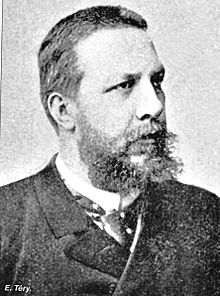Edmund Téry
Edmund Téry , Hungarian Ödön Téry , actually Edmundus Felix Anton Wilhelm Ricker (born July 4, 1856 in Altbeba , Torontál County , Kingdom of Hungary ; † September 11, 1917 in Budapest , Austria-Hungary ) was a German-Hungarian doctor, mountaineer and sponsor of tourism.
Life
Edmund Téry came from a German family from Austria . His original name was Edmundus Felix Anton Wilhelm Ricker . His father Joseph Ricker came to Altbeba, where he worked as an estate manager on the estate of Baron Sina. In the course of the wave of Magyarization in what was then the Kingdom of Hungary, he changed his name to "Téry" in 1862.
The young Edmund Wilhelm first attended grammar school in Mischkolz , where he also passed his Abitur . In 1865 he went to Pest , where he completed a medical degree at the local university . In addition to his studies, he did his military service as a volunteer. On November 7th, 1876 he married Emilie geb. Mészáros, the daughter of the Ministerial Councilor Ferenc Mészaros. The marriage resulted in two sons.
From 1880 he lived in Schemnitz , where he made a name for himself as a specialist in miners' diseases. He became the personal physician of Count Philipp von Coburg, the owner of the castle and the dominion of Sankt Anton in der Au at the time .
In 1884 Téry returned to Budapest, where he worked in the Ministry of the Interior.
Téry was a first-rate mountaineer with several first ascents and the most difficult mountain tours in the High Tatras between the years 1876 and 1878 (on August 5, 1876, he climbed the Lomnitzerspitze with the mountain guide Johann Still ; on August 6, 1877, he climbed the Schwalbenturm ( slow . Pyšný štít ) with mountain guide Martin Spitzkopf ). Many places in the area of the High Tatras are reminiscent of his name (e.g. the Téry peak, 2592 m, Malý Pyšný štít in Slovak ), Téry ridge, Téry saddle , etc. His initiative is also the construction of the Téry hut on a small scale Kaltwassertal in the High Tatras to thank. This shelter was opened to the public on August 21, 1899 and is still used today as a hostel for mountain hikers.
Téry was an active promoter of tourism, since 1875 he was a member of the Carpathian Association , where he did fundamental and future-oriented work. In 1882 Téry founded the “Sitno” section of the UKV. After his return to Budapest in 1888 he founded the “New Budapest Section” of the UKV together with Gustav Thirring, of which he became chairman. Téry was one of those functionaries of the UKV who wanted to move the headquarters of the association from Leutschau to Budapest in the nineties of the 19th century . When this project failed, the “New Budapest Section” of the UKV became independent. The independent "Magyar Turista Egyesület", MTE ( Hungarian Tourist Association ), founded on September 29, 1891, emerged from it, and Téry became its managing director.
After the outbreak of the First World War , he became involved as a military doctor and in the winter of 1916 he caught a severe cold on an inspection tour of various prison camps, from which he no longer recovered. He died in Budapest in September 1917, marked by severe asthma .
Téry was also active as a journalist, in 1889 he founded the Hungarian magazine "Turisták Lapja" ( tourist magazine ) of which he was editor-in-chief. He also published in the Carpathian Yearbook . One of his best-known contributions was “The First Climbing of the Middle Ridge” published in the Carpathian Yearbook, year 1879.
literature
- Ernst Hochberger: High Tatras, Mountains of Northern Slovakia, 4 vols., Sinn / Hessen 1992, ISBN 3-921888-06-9
- Anton Klipp: T he High Tatras and the Carpathian Association, Karlsruhe 2006, ISBN 3-927020-12-5
Web links
Individual evidence
- ↑ As part of an administrative reform, Altbeba was later attached to the Temes County .
- ^ Through the marriage of Ferdinand Georg von Sachsen-Coburg-Saalfeld with Princess Maria Antonia Gabrielle Koháry , the house Sachsen-Coburg-Koháry was created .
- ^ Hungarian Carpathian Association
| personal data | |
|---|---|
| SURNAME | Téry, Edmund |
| ALTERNATIVE NAMES | Ricker, Edmundus Felix Anton Wilhelm (real name); Téry, Ödön (huS) |
| BRIEF DESCRIPTION | German-Hungarian doctor, mountaineer and promoter of tourism |
| DATE OF BIRTH | 4th July 1856 |
| PLACE OF BIRTH | Altbeba , Torontál County , Kingdom of Hungary |
| DATE OF DEATH | September 11, 1917 |
| Place of death | Budapest , Austria-Hungary |

